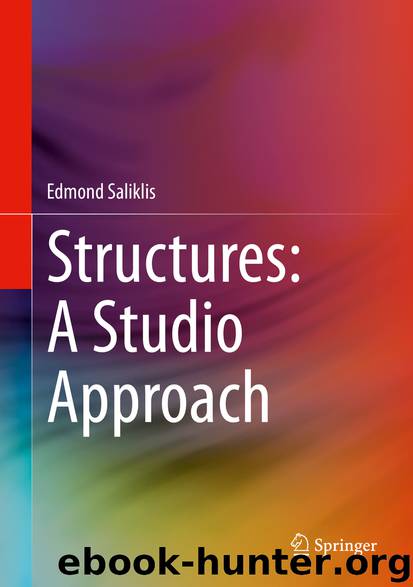Structures: A Studio Approach by Edmond Saliklis

Author:Edmond Saliklis
Language: eng
Format: epub
ISBN: 9783030331535
Publisher: Springer International Publishing
For lateral loading parallel to the numbered grids (1, 2, 3 etc.)., the walls aligned with the numbered grids 1 and 5 do all the resisting. They do so by acting as beams cantilevering up from the ground, and they bend in their strong direction. The walls aligned with lettered grids do nothing to resist load parallel to the numbered grids because they would flop over for such loads, they are not acting in the strong direction, so we assume they do not resist lateral loads at all.
Conversely, for loads in the lettered grid direction we have a different situation. For loading in the direction of A, B, C etc., the shear walls aligned with grids A, B, C and D are engaged and resist loads. The walls perpendicular to the load do nothing to resist loads. Thus, for loads parallel to the lettered grids, the wall along grid1 and grid5 do nothing at all, we assume they do not exist.
Next, imagine a lateral load moving parallel to the numbered grids in Fig. 7.5. If this were wind, the windward load might push, with a tributary area, onto the face in line with grid A. That wind load would be transferred to the diaphragm (not shown) and walls aligned with grid 1 and grid 5 resist. But then the diaphragm (not shown) continues over the gap in the walls along grid 5. The diaphragm is connected to the drag struts all along grid 5. For this loading, the strut between grids B and C along line5 experiences load. But when that load finally flows along the dashed red line in Fig. 7.5 all the way to the face on grid D, the perpendicular wall cannot resist anything. Thus, the axial force in the drag strut must be zero when it hits the perpendicular wall. Similarly, the axial force at point A5 must be zero, for this load along the numbered lines, as the wall on A cannot resist perpendicular load.
Referring back to Fig. 7.2, it is apparent that one side of the flexible diaphragm experiences tension, and the other side experiences compression. Tensile stresses and strains develop one side and compressive stresses and strains develop on the other side because the diaphragm acts as a beam in bending, and there is some internal moment M. These stresses are exactly the same ones studied in earlier classes, namely axial stresses induced by bending.
The moment M induces a Tension/Compression couple, and the tension force developed must balance the compression force. It is impossible to balance stresses, one only can balance forces. The tensile force is some distance, or ‘arm’ away from the compressive force.
Figure 7.6 shows a bent element, like our flexible diaphragm, being flexed by a bending moment. This induces compression on one side of the neutral axis and tension on the opposite side of the neutral axis. The net compression is symbolized by C acting not at the centroid of the compressed area, but rather at the extreme edge. Similarly,
Download
This site does not store any files on its server. We only index and link to content provided by other sites. Please contact the content providers to delete copyright contents if any and email us, we'll remove relevant links or contents immediately.
Audition by Ryu Murakami(4583)
The Body: A Guide for Occupants by Bill Bryson(4539)
Adulting by Kelly Williams Brown(4197)
Housekeeping by Marilynne Robinson(4016)
Be in a Treehouse by Pete Nelson(3622)
Zero Waste Home by Bea Johnson(3617)
Seriously... I'm Kidding by Ellen DeGeneres(3389)
Better Homes and Gardens New Cookbook by Better Homes & Gardens(3346)
The Healing Self by Deepak Chopra(3195)
Barkskins by Annie Proulx(3177)
The Life-Changing Magic Of Tidying Up- The Japanese Art Of Decluttering And Organizing (v5.0) by Marie Kondo(3072)
Hedgerow by John Wright(3064)
The Cellar by Natasha Preston(3059)
Spark Joy by Marie Kondo(3056)
The Genius of Japanese Carpentry by Azby Brown(3010)
120 Days of Sodom by Marquis de Sade(2908)
Work Clean by Dan Charnas(2870)
A Monk's Guide to a Clean House and Mind by Shoukei Matsumoto(2763)
The Book of Numbers by Peter Bentley(2744)
